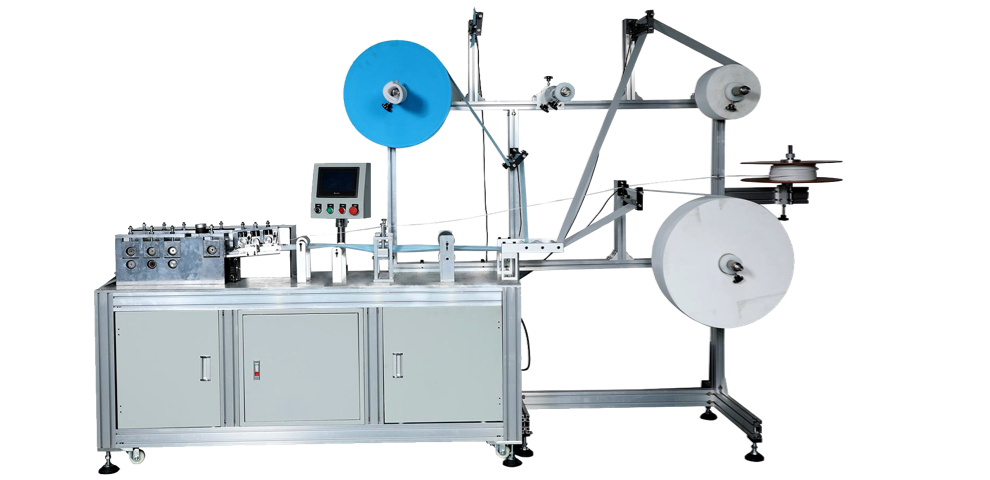Spunlace nonwoven fabric is a kind of fabric made by the spunlace nonwoven machinery which adopts the process of spraying high-pressure fine water flow onto one or more layers of fiber webs, so that the fibers are entangled with each other and the fiber web can be reinforced and have a certain strength. The fiber raw materials come from a wide range of sources, such as polyester, nylon, polypropylene, viscose fiber, chitin fiber, microfiber, tencel, silk, bamboo fiber, wood pulp fiber, seaweed fiber, etc.
Spunlace composite technology
The research and development of spunlace composite technology not only overcomes the limitations of some nonwoven products, increases the variety of colors, greatly broadens the application field of spunlace nonwoven fabrics, but also promotes the development of spunlace technology and even the entire nonwoven process.
(1) Spunlace and wood pulp airlaid composite technology. Since the price of wood pulp is much cheaper than that of short fibers commonly used in spunlace, and the fluff pulp has good hygroscopicity and hand feel, the resulting products are cheaper than all fiber-based products, and are very competitive in price.But in terms of technology, the requirements for the filter system are very high. The product can be used as a wiper (70%g/m2), diaper and sanitary napkin inner core material. The equipment for spunlace and wood pulp air-laid compounding includes Aquapulp of Fleissner Company and Airlace of Perfojet Company.
(2) Composite technology of spunlace and filament spunbond web. The composite product of this method has both the strength of the spunbond nonwoven fabric and the good absorption performance of short fibers, and is even and softer than the spunbond nonwoven fabric, has the function of absorbing water and oil, and has high strength, which can be used as food wrap , decorative cloth and cleaning cloth, etc. The equipment of spunlace and spunbond compound method includes Aquqspun and Aquasplit of Flerssner Company, and Evolon processing technology of Freudenberg Company.
(3) Spunlace and wet-laid composite technology. The Hydraspun technology of Detex is composed of the wet-laid technology of Detex combined with the Soflom spunlace method registered by Unicharm of Japan. The strength and softness of Hyderaspun wet spunlace nonwovens are equal to or even exceed those of traditional dry spunlace nonwoven. Moreover, the wet spunlace nonwoven does not lose lint, and its seam tensile strength is twice that of the dry spunlace, which is especially suitable for the clothing field.

New technological progress
Memis Acar, from the Department of Mechanical Engineering at Loughborough University in the UK, has proved that the spunlace method can process glass fibers to produce industrial fabrics. Due to glass fibers are not crimped, the traditional thinking is that dry nonwoven methods are difficult to process. Most glass fiber nonwovens are generally processed by needle punching or wet-laid processes, but North Carolina State University (NCSU) has successfully developed glass fiber and polyester blended spunlace nonwovens. Thick denier glass fiber with a diameter of 16um is difficult to process by spunlace method. If it is mixed with fine denier glass fiber with a diameter of 6.5um, it will help to improve the strength of the spunlace nonwoven. It is beneficial to spunlace, and the coarse denier fiber is beneficial to improve the strength of spunlace nonwovens. If glass fibers are mixed with textile staple fibers such as polyester, the hydroentanglement ability can be enhanced. Mixing glass fiber with low melting point polyester can produce glass native reinforced polyester composites.
Using NGSN equipment, researchers at Auburm University in the United States found that hydroentanglement can produce geotextiles, which are produced by needle punching and hot rolling. The researchers found that changing the spunlace pressure and the time the web was exposed to water needles could change the pore size of the geotextile. Pore size is a key indicator of geotextiles, especially when used as a sand filter, allowing water to pass through and preventing soil movement. Extending the time that the fiber web is subjected to the action of water needles or increasing the spunlace pressure can enhance the spunlace entanglement effect of the fiber web and reduce the pore size of the fabric. The aperture size can be adjusted online without stopping, thereby increasing the production speed, which is more flexible and simpler than other processing techniques of geotextiles.
New technology for functional finishing of fabrics: In 1995, BBA Company in the United States developed the Interspun process and applied for a patent. Using this process, the surface of the fabric is treated by hydroentanglement, which can have a positive impact on the structure and performance of the fabric. In 1998 BBA signed a cooperation agreement with Fleissner, the exclusive machine supplier for this technology. Fleissner's Aquatex is a system for the treatment of woven fabrics with hydroentanglement, which is called a revolutionary measure for the finishing process of woven fabrics. After the woven fabric is hydroentangled, the yarns in the fabric are loosened and the fabric is effectively cleaned. Depending on the arrangement of the hydroentanglement head, the effect of peach skin can be obtained on both sides or one side of the fabric. It can also eliminate the stress generated by the fabric during the process and make the warp yarns more uniform, thereby improving the feel and appearance of the fabric, increasing the thickness of the fabric, making the fabric softer. The abrasion resistance is more than 300% of that when untreated, the phenomenons of slippage at the sewing place is almost decreased 50%, the anti-pilling performance is improved, the wrinkle resistance is improved, the cloth surface is more uniform, the pores on the cloth surface are reduced, and the distribution is more uniform. Therefore, after spunlace treatment, processes such as desizing, scouring, mercerizing, and sanding can be eliminated, and the bleaching process can also be simplified, which has obvious comprehensive economic benefits.




